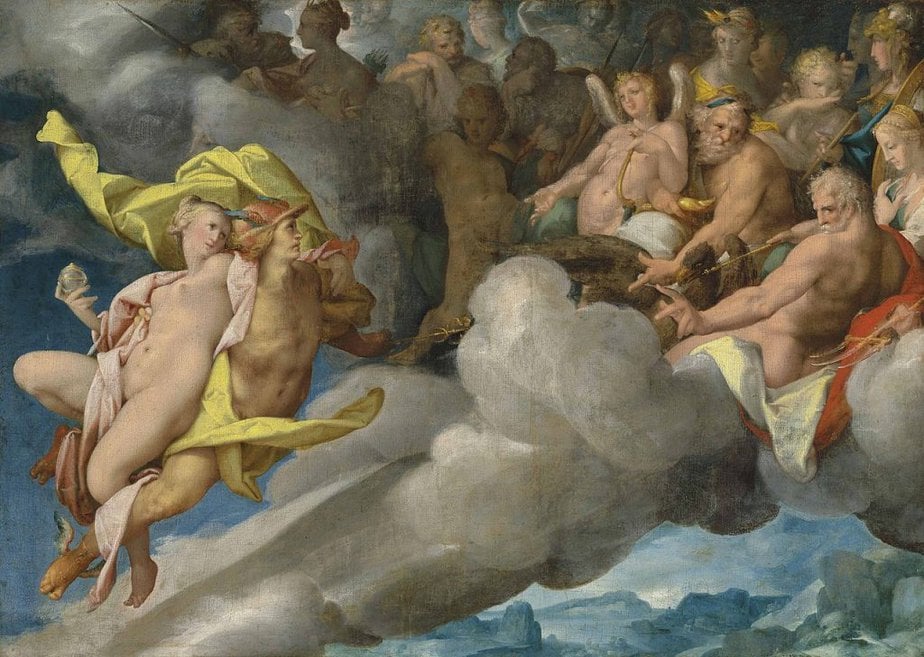Bartholomeus Spranger, born in 1546, was a Flemish painter. Spranger is most well known for his attempts to develop a Northern artistic body of work focusing on human anatomy. In this vein, the majority of his work is nudes in the Mannerist style.
Spranger, the son of a trader, was interested in drawing from a young age. During his formative years, he was involved in apprenticing for three master landscape painters, staying on with his final mentor to work in his studio for two years.
In 1565, Spranger decided to travel further afield. He went first to Paris, before setting up in Italy for 8 months while he helped paint the dome of a church in Parma, Italy. He continued to find work painting churches in Italy, until, in 1570, he was appointed court painter by the incumbent Pope.
He held this position for five years until he was employed by Maximillian II, Holy Roman Emperor, in Vienna. Maximilian died six years after this summoning but his successor, Rudolf II, was even more interested in employing Spranger.
Spranger lived out his days as the court painter for the Roman Empire. He moved to Prague, where the court had moved its seat, and lived in a house and adjoining studio outside the castle walls.
It was in this studio that Spranger painted some of his most famous pieces. These pieces almost always contained nude bodies, entangled in elaborate poses. He was able to create political and religious allegories with the erotically charged subject matter, something the Roman Emperor was particularly fond of. He was also tasked with creating propaganda for the Emperor, something he did with appropriate artistic license.
The elegance and technique in Spranger’s work are characteristic of the Northern Mannerism style, although the artist himself tried to exclude himself from the “Northern” vs “Southern” debate. Spranger died in his home in Prague in 1611.
1. Mountain Landscape With a Hermit
‘Mountain landscape with a hermit’ was created in c.1569 by Bartholomeus Spranger in Mannerism style.
2. Saint Andrew
‘Saint Andrew’ was created in 1575 by Bartholomeus Spranger in the Late Renaissance style
3. Figure Studies
‘Figure Studies’ was created in c.1575 by Bartholomeus Spranger in the Mannerism style.
4. Lamentation Of Christ
‘The Baptism of Christ’ was created in the year 1603 by Bartholomeus Spranger in Mannerism (Late Renaissance) style.
5. Strength
‘Lamentation of Christ’ was created in c.1576 by Bartholomeus Spranger in Mannerism (Late Renaissance) style.
6. Ecce Homo
‘Ecce Homo’ was created in c.1580 by Bartholomeus Spranger in Mannerism (Late Renaissance) style.
7. March On The Battlefield
‘March On The Battlefield’ was created in 1580 by Bartholomeus Spranger in Mannerism (Late Renaissance) style.
8. Glaucus And Scylla
‘Glaucus and Scylla’ was created in the year c.1582 in Mannerism (Late Renaissance) style by Bartholomeus Spranger.
9. God The Father With The Holy Spirit And Angels
‘God the Father with the holy spirit and Angels’ was produced in the year c.1582 by Bartholomeus Spranger in Mannerism (Late Renaissance) style.
10. Saint Catherine
‘Saint Catherine’ was created in c.1583 by Bartholomeus Spranger in Mannerism (Late Renaissance) style.
11. Self-Portrait
‘Self-portrait’ was created in c.1585 by Bartholomeus Spranger in the Mannerism (Late Renaissance) style.
12. Venus And Mercury
‘Venus and Mercury’ was made in 1585 by Bartholomeus Spranger in Mannerism (Late Renaissance) style.
13. Diana And Actaeon
‘Diana and Actaeon’ was created in 1585 by Bartholomeus Spranger in Mannerism (Late Renaissance) style.
14. Hermes And Athena
‘Hermes and Athena’ was created by Bartholomeus Spranger in the year 1585 in Mannerism (Late Renaissance) style.
15. Apollo And The Muse
‘Apollo and the Muse’ was produced in the year 1590 by Bartholomeus Spranger in Mannerism (Late Renaissance) style.
In conclusion, Bartholomeus Spranger, a prominent figure of the late Renaissance, left an indelible mark on the art world with his unique interpretation of Mannerism. Through mythological and allegorical themes, he crafted works that showcased elongated figures, graceful poses, and intricate details. Spranger’s ability to traverse courts across Europe and gain patronage speaks to the universal appeal of his art. His paintings, such as “Hercules and Omphale” and “Venus and Adonis,” exemplify his mastery in merging classical themes with the elaborate aesthetics of the Mannerist style. Although not as widely celebrated as some of his contemporaries, Spranger’s influence on the Northern European Mannerist movement remains significant, marking him as a key contributor to the rich tapestry of art history.
The article contains sponsored affiliate links from Amazon to valuable resources.


